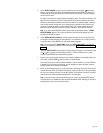page 22
Once you locate your pulse, look at a clock with a second hand, and count the beats for six
seconds. Multiply that number by 10 to determine the total number of beats per minute. For
example, if you count 14 beats over six seconds, the total number of beats per minute is 140.
Compare the total number of beats with your training zone as identified in Diagram 14. If neces-
sary, increase or decrease your activity level to bring your heart rate into your training zone. You
can regulate your work level (and heart rate) by changing belt speed and incline. Remember—
your heart rate is the definitive measure of how hard you are working.
Regardless of your fitness level, avoid doing too much too soon. Running or walking too fast or
choosing too high of an incline are common errors. Give yourself time to become familiar with
your treadmill and to improve your fitness level. Then you can gradually increase speed and incline
to make your workouts more challenging.
How Long Should I Exercise?
The length of each exercise session depends on your fitness level. Exercise physiologists have
determined that, to attain cardiovascular benefits from exercise, you should maintain your heart
rate in its training zone for at least 15 minutes. This is in addition to your warm-up time, and does
not include cool down. You should always allow several minutes to bring your heart rate into the
training zone, by starting out slowly and gradually increasing work level. Similarly, use several
minutes of light exercise after the workout to bring your heart rate down to near resting level.
The higher your fitness level, the longer you should maintain your heart rate in the training zone
(between 20 and 30 minutes). Beginners should always start slowly, and gradually bring their
sessions up to 20 minutes or more.
How Often Should I Exercise?
Research indicates that aerobic sessions of 20 minutes or more should be done at least three to
five times a week to obtain significant cardiovascular benefits. Most experts agree that sensible
eating habits and regular aerobic exercise are the keys to weight control and fitness. A recent
study, which tracked several subjects over a period of years, conclusively shows that exercise, not
dieting, is the key factor to long-term weight loss.


















